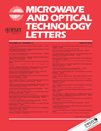Compact dual-band MIMO antenna for 4G USB dongle applications
Abstract
An extremely compact dual-band MIMO antenna for 4G USB dongle applications is proposed for operation in the long term evolution (LTE) band 13 (0.746–0.787 GHz) and the M-WiMAX band (2.5–2.69 GHz).The proposed multiple-input multiple-output (MIMO) antenna consists of two identical elements, each of which is 15 × 13.25 mm2. The minimum separation between the two elements is 0.5 mm (about 0.13% of the wavelength in free space at 0.765 GHz). Each antenna element of the proposed MIMO system is composed of a feeding strip, a spiral-like radiating strip, and an L-shaped parasitic strip. The radiating and L-shaped strips are short-circuited to the ground plane. The radiating and parasitic strips, which are capacitively coupled to the feeding strip, operate not only as radiators but also work as resonators to reduce the coupling between the two closely packed input ports. The proposed MIMO antenna has a measured port-to-port isolation performance of more than 13 dB over the frequency bands of interest. In addition, the ECCs are maintained below 0.3. © 2012 Wiley Periodicals, Inc. Microwave Opt Technol Lett 54:744–748, 2012; View this article online at wileyonlinelibrary.com. DOI 10.1002/mop.26612




